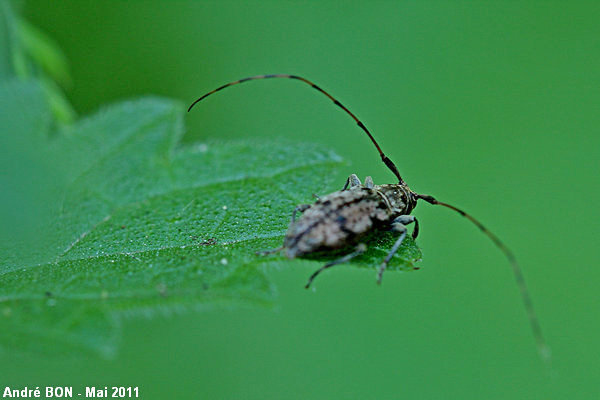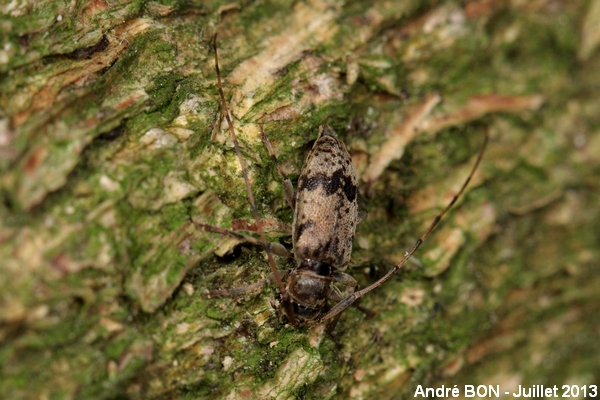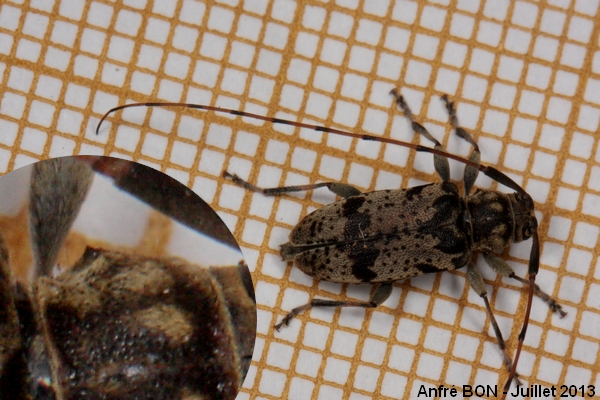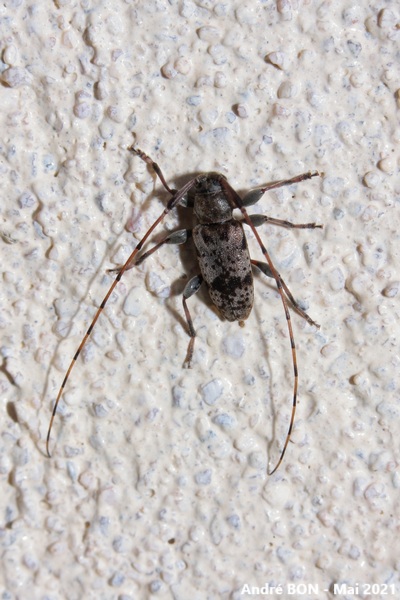




| Leiopus femoratus (Fairmaire, 1859) |





|
|
Scientific name: Leiopus femoratus (Fairmaire, 1859) Common name: French name: Order: Coleoptera Family: Cerambycidae Wingspan : 5 to 9 mm. Biotope: Proximity of deciduous trees (Oaks, Alders, Limes). Geographic area: Europe, Russia, Iran, Turkey. Observation period : April to July. |
Leiopus femoratus is a relatively small sized longhorn beetle. The antennae are longer than the body on both sexes. They deviate from each other from their base. The first article is rather long, swollen and club-shaped, the second one is very short, the other ones are cylindrical. The length of the third article is greater than the total length of the first two articles. Each antennal article shows a pale area followed by a black area. This black area does not cover more than a quarter of the article. The head is blackish. The ashy grey pronotum is the same width as the head at he front. I shows a lateral spine on each side. These spines are clearly positioned on the second half. The elytra are an ashy grey colour with blackish marks, often more visible at the base and forming a cross stripe shortly after the middle. The legs are blackish grey. The thighs are swollen and club-shaped. The Black-clouded Longhorn Beetle (Leiopus nebulosus) has much darker antennae. The black area exceeds half of the length of each article. It also shows a third article which is about the same length as the total length of the two first ones. You can also find Leiopus linnei, separated from Leiopus nebulosus in 2009 by DNA analysis. It is very similar to Leiopus nebulosus. The longhorn beetles of the Acanthocinus genus are a slightly larger size and are mainly linked to conifers. Leiopus punctulatus is linked to Poplar Trees. The marks on the elytra are more contrasted, with a black area near the base and a broad cross stripe at about two thirds of the length. The pale areas are punctuated by some rather large black dots. |
| [To know more about the Leiopus femoratus] [Next picture] [Top] |

|
I absolutely wanted to shoot this picture without using the flash. As I had my tripod with me, I have easily adjusted the focus on the eyes of the insect. But the very short depth of field, because of the lack of light and because the vegetation was agitated, gives a too much blurred picture. The antennae appear dark because of the lack of light, but a close view of the non reduced picture allows to see that the black areas cover less than one quarter of each article. The third article is long. |
| [To know more about the Leiopus femoratus] [Next picture] [Previous picture] [Top] |

|
I have found this longhorn beetle on a wood log in my garden. Its general colour provides a good camouflage on tree bark. |
| [To know more about the Leiopus femoratus] [Next picture] [Previous picture] [Top] |

|
I have been able to put this longhorn beetle on a sheet of graph paper. The body length is measured at 9 mm and the antennae length at 16mm. You can clearly see the lateral spine on the side of the pronotum but I don't really know how to use this criterion because I have read everything and its opposite. |
| [To know more about the Leiopus femoratus] [Next picture] [Previous picture] [Top] |

|
A long third antennal article and antennae with very small black areas, I hope this is enough to identify Leiopus femoratus. |
| [To know more about the Leiopus femoratus] [Previous picture] [Top] |

|
The antennae and the shape of the pronotum are clearly visible in this top view. |